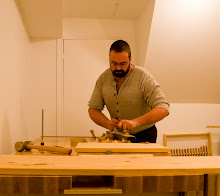
There are different ways to scrape a flat surface. Above we see the three most common methods for furniture. Leftmost is a card scraper, which is simply a rectangle of sheet metal which, properly sharpened, will do a lovely job. Behind is a scraping plane, and to the right is a cabinet scraper.
Each method has its pros and cons. The most maneuverable and by far the cheapest is the card scraper. Since the card scraper is held in the hands you can hold it at whatever angle you like. You can push or pull it as you like. You can work on a tiny area of tear-out without affecting the area nearby, and you can work pretty far into a corner when you need to. These are all good things. The drawback to a card scraper is that it is by far the most physically demanding to use. Your thumbs get hot, and your hands get tired. It's miserable to do a large piece with a card scraper. Additionally, since it has no 'sole' it can't be relied on at all to level a piece or even keep an already-level piece level. It can dig into softer areas. You get a smooth finish, but not necessarily a flat one.
The cabinet scraper is more expensive. It's far less physically demanding to use, and it has a sole so it keeps the surface reasonably level. The main drawback is that you can't 'finesse' it much. The scraper blade is held at an angle set by the cast-in angle of the body. You can adjust the hook of the scraper blade to make the unit cut more or less aggressively, and you can add more or less pressure on the screw to adjust the aggressiveness, but you're still locked in to that angle.
The scraper plane has the longest sole, so it keep the surface the flattest. This also means that it is not very useful for working small areas of reversing grain. The scraper plane is the most expensive, but while it shares the ease of use of the cabinet scraper it also has a level of adjustability that the cabinet scraper can't even dream of - you can adjust the angle. This means that you can take a wide, thin shaving, or a narrow, thin shaving without re-tuning the blade. You can fine-tune the presentation of the blade to the wood and you are done - all that's left is to push it. No stress, no anguished thumbs. It's lovely.
Note that a scraper should take shavings as seen below. If all you are getting is dust then you need to sharpen your scraper... but that's a posting for another day.


No comments:
Post a Comment